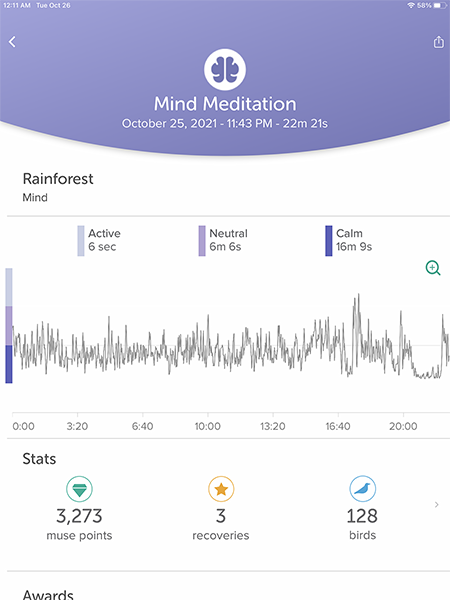Background.
Meditation is to the brain
- as Cardio is to the heart or
- as resistance training is to the muscles.
When you managed to induce that state in your brain, you are making your brain stronger. This has been demonstrated in a number of clinical ways, oh any by Easter Civilization over the past several millennium.
This merges a few things from Thinking Fast and Slow and How to Change Your Mind. I won’t be referring to either specifically, but I recommend both books.
Meditation
I recently used my Muse headband to measure how well I was able to keep my mind relaxed while stretching.
Have a look at a graph from one such experience:

Quick Background
The graph has three lanes:
- Top, Light Purple, Active
- Middle, Medium Purple, Neutral
- Bottom, Dark Purple, Calm
The goal is more calm.
Task
I was slowly, and deeply stretching throughout this session. Near the end of these sessions, I compress my spine onto the floor. First, I lie on my back, with my feet on the ground, and my knees bent. I engage my core muscles to slowly press my spine into the (carpeted) floor, starting from my tailbone, and working up my spine between my shoulder blades. It takes effort to build this up, and continued effort and concentration to hold it, while breathing correctly, and keeping my neck relaxed. This is a task that requires focus and concentration both to enter and maintain.
If you look at the graph again, near the end of the time-line, the graph is flat. FLAT. That means I was in a deep calm state, as measured by the headband. I have read that being task-focused is another way to get the brain to enter a calm state. There’s another name for this, Flow.
One of the effects of meditation is to suppress the default mode network. Doing so may change your perception as one task done by the DMN is to filter (reduce) sensory input to conserve energy. However, something else magical happens when the DMN is suppressed. The rest of the brain can start to communicate because the DMN isn’t dominating the communication channels. Your creativity soars as strangers in you own head hold an informal house party. Your ego drops away. Time does not exist.
I’ve written about earlier experiences with meditation. Suffice it to say, I’m sold on the long-term benefits, and the time I spend daily feels well worth it.
Flow / Meditation
I’ve experimented with different ways of inducing a calm state as measured by Muse. These are:
- Sitting Meditation
- Moving meditation (walking, stretching)
- Specific breathing patterns (e.g., Wim Hof, Dirga Pranayama)
- Slow Moving Internal Martial Arts (Tai Chi, Bagua , Liuhebafa)
I think there’s also a tie-in here to the idea of psychological safety. I’m not sure if they are
- nearly the same thing
- one is necessary for the other
- a ven diagram of the two shows a bit of overlap
But in any case, while I expected some change in my brain waves during this recent experiment, I was quite surprised at how flat it was. The flatness of the line was in direct relationship to the effort of the exercise. In other cases, where I have a similar graph shape, but for a longer duration, my brain feels like the best kind of mush after the experience.
 Collected works and current thoughts
Collected works and current thoughts
